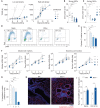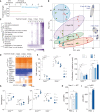Type I and III interferons disrupt lung epithelial repair during recovery from viral infection
- PMID: 32527928
- PMCID: PMC7292500
- DOI: 10.1126/science.abc2061
Type I and III interferons disrupt lung epithelial repair during recovery from viral infection
Abstract
Excessive cytokine signaling frequently exacerbates lung tissue damage during respiratory viral infection. Type I (IFN-α and IFN-β) and III (IFN-λ) interferons are host-produced antiviral cytokines. Prolonged IFN-α and IFN-β responses can lead to harmful proinflammatory effects, whereas IFN-λ mainly signals in epithelia, thereby inducing localized antiviral immunity. In this work, we show that IFN signaling interferes with lung repair during influenza recovery in mice, with IFN-λ driving these effects most potently. IFN-induced protein p53 directly reduces epithelial proliferation and differentiation, which increases disease severity and susceptibility to bacterial superinfections. Thus, excessive or prolonged IFN production aggravates viral infection by impairing lung epithelial regeneration. Timing and duration are therefore critical parameters of endogenous IFN action and should be considered carefully for IFN therapeutic strategies against viral infections such as influenza and coronavirus disease 2019 (COVID-19).
Copyright © 2020 The Authors, some rights reserved; exclusive licensee American Association for the Advancement of Science. No claim to original U.S. Government Works.
Figures




Comment in
-
Interferon responses in viral pneumonias.Science. 2020 Aug 7;369(6504):626-627. doi: 10.1126/science.abd2208. Science. 2020. PMID: 32764056 No abstract available.
-
Interferon-λ at the Center of the Storm.Immunity. 2020 Aug 18;53(2):245-247. doi: 10.1016/j.immuni.2020.07.024. Immunity. 2020. PMID: 32814024 Free PMC article.
References
-
- Channappanavar R., Fehr A. R., Vijay R., Mack M., Zhao J., Meyerholz D. K., Perlman S., Dysregulated type I interferon and inflammatory monocyte-macrophage responses cause lethal pneumonia in SARS-CoV-infected mice. Cell Host Microbe 19, 181–193 (2016). 10.1016/j.chom.2016.01.007 - DOI - PMC - PubMed
Publication types
MeSH terms
Substances
Grants and funding
LinkOut - more resources
Full Text Sources
Other Literature Sources
Molecular Biology Databases
Research Materials
Miscellaneous

